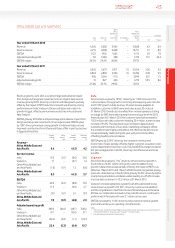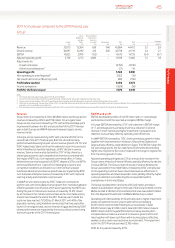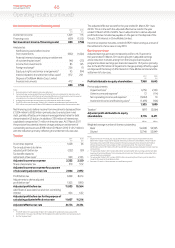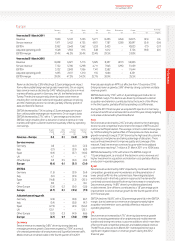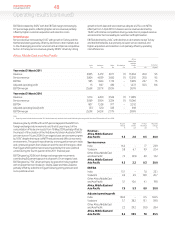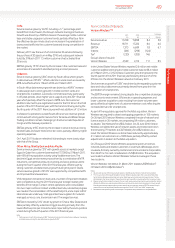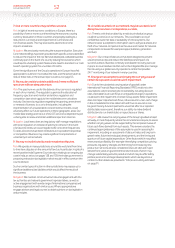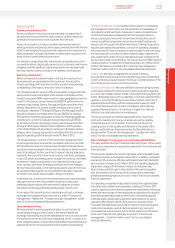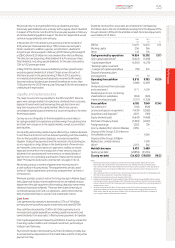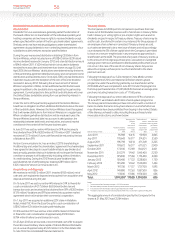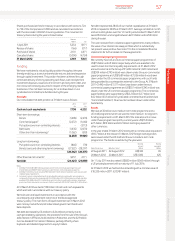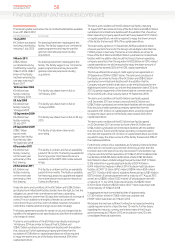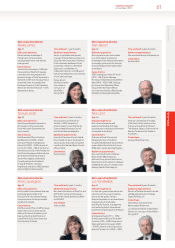Vodafone 2012 Annual Report Download - page 54
Download and view the complete annual report
Please find page 54 of the 2012 Vodafone annual report below. You can navigate through the pages in the report by either clicking on the pages listed below, or by using the keyword search tool below to find specific information within the annual report.
52
Vodafone Group Plc
Annual Report 2012
Principal risk factors and uncertainties (continued)
7. One or more countries may exit the eurozone.
Risk: In light of recent economic conditions in Europe, there is a
possibility of one or more countries exiting the eurozone, causing
currency devaluation in those countries and possibly leading to a
reduction in our revenue and impairment of our nancial and
non-nancial assets. This may also lead to adverse economic
impactselsewhere.
Mitigation: We are closely monitoring the eurozone situation. Executive
Committee briengs have been provided with specic actions identied
to reduce the impact of the risk. We have developed a detailed business
continuity plan in the event of a country leaving the eurozone, which
could lead to a banking system freeze and a need to transition to a “cash
based” operating system for a number of months.
Given the signicance of the Group’s operations in Europe it was felt
appropriate to outline in more detail the risks, and the action taken to
reduce these risks, in the annual report, as set out on page 53.
8. We may be unable to obtain additional/renew sufcient
spectrum with an adequate return.
Risk: The spectrum we use for the delivery of our services is regulated
ineach of our markets. The regulators supervise the allocation of
frequency spectrum and monitor and enforce regulation and
competition laws which apply to the mobile telecommunications
industry. Decisions by regulators regarding the granting, amendment
orrenewal of licences, to us or to third parties, including the
implementation of unsustainable cost and revenue models, could
adversely affect our future operations in these geographic areas. Our
mobile data strategy and roll out of 4G/LTE services is dependent upon
us being able to renew and obtain additional spectrum licences.
Mitigation: Local executives and regulatory staff manage negotiations
with local regulators on renewal of spectrum licences. In the event
ofafailure to renew, we could migrate trafc onto other frequencies.
Todate,all licences have been renewed but it is possible that political
orcompetitor inuences may create signicant complications or
uncertainty in some markets.
9. We may not satisfactorily resolve major tax disputes.
Risk: We operate in many jurisdictions around the world and from time
to time have disputes on the amount of tax due. In particular, in spite of a
recent positive India Supreme Court decision relating to an ongoing tax
case in India, as set out on pages 138 and 139, the Indian government is
proposing retroactive tax legislation which would in effect overturn the
court’s decision.
Such or similar types of action in other jurisdictions may expose us to
signicant additional tax liabilities which would affect the results of
thebusiness.
Mitigation: We maintain constructive but robust engagement with the
tax authorities and relevant government representatives, as well as
active engagement with a wide range of international companies and
business organisations with similar issues. Where appropriate we
engageadvisors and legal counsel to obtain opinions on tax legislation
and principles.
10. A malicious attack on our network may be successful and
disrupt our services or compromise our data.
Risk: There is a risk that an attack by a malicious individual or group
could be successful on our networks. This could lead to a loss of
condential customer data or availability of critical systems. Our
network is also susceptible to interruption due to a physical attack and
theft of our network components as the value and market for network
components increases (for example copper, batteries, generators
andfuel).
Mitigation: Our critical infrastructure has been designed to prevent
unauthorised access and reduce the likelihood and impact of a
successful attack. Business continuity and disaster recovery plans are
inplace to cover residual risk that cannot be mitigated. We also manage
the risk using our global security operations centre that provides
24/7monitoring of our network in many countries.
11. Changes in assumptions underlying the carrying value of
certain Group assets could result in impairment.
Risk: Due to the substantial carrying value of goodwill under
International Financial Reporting Standards (‘IFRS’), revisions to the
assumptions used in assessing its recoverability, including discount
rates, estimated future cash ows or anticipated changes in operations,
could lead to the impairment of certain Group assets. While impairment
does not impact reported cash ows, it does result in a non-cash charge
in the consolidated income statement and thus no assurance can
begiven that any future impairments would not affect our reported
distributable reserves and, therefore, our ability to make dividend
distributions to our shareholders or repurchase our shares.
Mitigation: We review the carrying value of the Group’s goodwill at least
annually, or more frequently where the circumstances require, to assess
whether carrying values can be supported by the net present value of
future cash ows derived from such assets. This review considers the
continued appropriateness of the assumptions used in assessing for
impairment, including an assessment of discount rates and long-term
growth rates, future technological developments, and the timing and
quantum of future capital expenditure. Other factors which may affect
revenue and protability (for example intensifying competition, pricing
pressures, regulatory changes and the timing for introducing new
products or services) are also considered. Discount rates are in part
derived from yields on government bonds, the level of which may
change substantially period to period and which may be affected by
political, economic and legal developments which are beyond our
control. Further details are provided in “Critical accounting estimates”
onpage 91.



